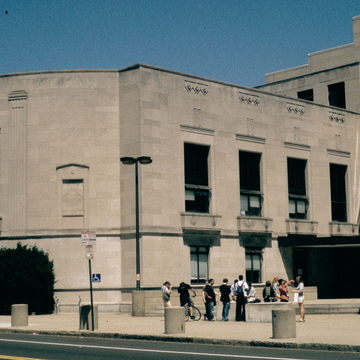Frederick Hastings Rindge, Cambridge's greatest benefactor, provided funds for the city hall, the public library, and the city's first industrial school in 1888. The Rindge Manual Training School (1888, Rotch and Tilden) gradually evolved from a trade school to one that provided broader technical training. Its success led to the replacement of the original school with a new Rindge Technical School in 1932, providing a dramatic shift in architectural style that was symbolic of changes in curriculum. Similar to his Motor Mart Garage (TD20) on Park Square, Boston, Doane used limestone in the Moderne style, with stylized pilasters and other classical forms to ornament the main entrance and the rounded auditorium wing on Broadway.
In 1976–1977, Eduardo Catalano designed a new building for the Cambridge Latin School at its merger with Rindge, replacing the old Latin School (1898, Hartwell, Richardson and Driver) and the Cambridge High and Latin School (1939, Charles R. Greco), both demolished. The three-story Brutalist poured concrete and glass structure is linked to the Rindge building by a second-story connector that permits access to the nearby public library from Cambridge Street. An Argentine-born architect then teaching at MIT, Catalano skillfully blended the new masonry and fenestration with the limestone of the existing building.















